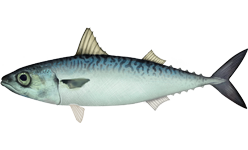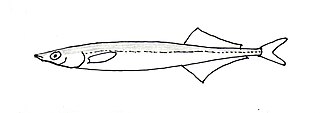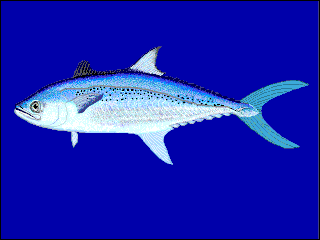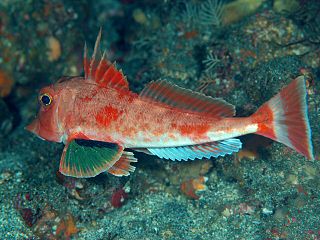
Aquaculture, also known as aquafarming, is the controlled cultivation ("farming") of aquatic organisms such as fish, crustaceans, mollusks, algae and other organisms of value such as aquatic plants. Aquaculture involves cultivating freshwater, brackish water and saltwater populations under controlled or semi-natural conditions, and can be contrasted with commercial fishing, which is the harvesting of wild fish. Mariculture, commonly known as marine farming, refers specifically to aquaculture practiced in seawater habitats and lagoons, opposed to in freshwater aquaculture. Pisciculture is a type of aquaculture that consists of fish farming to obtain fish products as food.

A tuna is a saltwater fish that belongs to the tribe Thunnini, a subgrouping of the Scombridae (mackerel) family. The Thunnini comprise 15 species across five genera, the sizes of which vary greatly, ranging from the bullet tuna up to the Atlantic bluefin tuna, which averages 2 m (6.6 ft) and is believed to live up to 50 years.

Mackerel is a common name applied to a number of different species of pelagic fish, mostly from the family Scombridae. They are found in both temperate and tropical seas, mostly living along the coast or offshore in the oceanic environment.

The Eurasian otter, also known as the European otter, Eurasian river otter, common otter, and Old World otter, is a semiaquatic mammal native to Eurasia. The most widely distributed member of the otter subfamily (Lutrinae) of the weasel family (Mustelidae), it is found in the waterways and coasts of Europe, many parts of Asia, and parts of northern Africa. The Eurasian otter has a diet mainly of fish, and is strongly territorial. It is endangered in some parts of its range, but is recovering in others.

Steller's sea eagle, also known as Pacific sea eagle or white-shouldered eagle, is a very large diurnal bird of prey in the family Accipitridae. It was described first by Peter Simon Pallas in 1811. No subspecies are recognised. A sturdy eagle, it has dark brown plumage with white wings and tail, a yellow beak, and yellow talons. Typically, it is the heaviest eagle in the world, at about 5 to 10 kg, but in some standard measurements, may be ranked below the harpy eagle and the Philippine eagle.

The chub mackerel, Pacific mackerel, or Pacific chub mackerel is a species of fish in the tuna and mackerel family, Scombridae. This species of mackerel closely resembles the Atlantic chub mackerel.

The largehead hairtail or beltfish is a member of the cutlassfish family, Trichiuridae. This common to abundant species is found in tropical and temperate oceans throughout the world. The taxonomy is not fully resolved, and the Atlantic, East Pacific and Northwest Pacific populations are also known as Atlantic cutlassfish, Pacific cutlassfish and Japanese cutlassfish, respectively. This predatory, elongated fish supports major fisheries.

Fresh fish rapidly deteriorates unless some way can be found to preserve it. Drying is a method of food preservation that works by removing water from the food, which inhibits the growth of microorganisms. Open air drying using sun and wind has been practiced since ancient times to preserve food. Water is usually removed by evaporation but, in the case of freeze-drying, food is first frozen and then the water is removed by sublimation. Bacteria, yeasts and molds need the water in the food to grow, and drying effectively prevents them from surviving in the food.

Acheilognathus is a genus of cyprinid fish native to Asia. The name is derived from the Greek a, meaning "without", the Greek cheilos, meaning "lip", and the Greek gnathos, meaning "jaw".

The Alaska pollock or walleye pollock is a marine fish species of the cod genus Gadus and family Gadidae.

The Korean sandlance is a species of marine ray-finned fish belonging to the family Hypoptychidae. The Korean sandlance is the only species in this monotypic family and genus and is found in the northwestern Pacific Ocean.

The Okhotsk atka mackerel, also known as the Arabesque greenling, is a mackerel-like species in the family Hexagrammidae. It is commonly known as hokke in Japan and imyeonsu in Korean. The primary population of the fish is found off the Sea of Okhotsk. According to legend, it was discovered by Nichiji.

The anglerfish are fish of the teleost order Lophiiformes. They are bony fish named for their characteristic mode of predation, in which a modified luminescent fin ray acts as a lure for other fish. The luminescence comes from symbiotic bacteria, which are thought to be acquired from seawater, that dwell in and around the sea.

The so-iuy mullet, also known as the haarder, redlip mullet or so-iny mullet, is a species of fish in the family Mugilidae.
Konosirus punctatus is a species of fish in the family Clupeidae, the herrings and sardines. It is the only member of the monotypic genus Konosirus. Its common names include dotted gizzard shad and konoshiro gizzard shad. It is native to the northwestern Pacific Ocean, where it occurs along the Asian coastline.

The Japanese Spanish mackerel, also known as the Japanese seer fish, is a species of true mackerel in the scombrid family (Scombridae). Their maximum reported length is 100 cm, and the maximum reported weight is 10.57 kg.

The Korean mackerel also known as the Korean seerfish, is a ray-finned bony fish in the family Scombridae, better known as the mackerel family. More specifically, this fish is a member of the tribe Scomberomorini, the Spanish mackerels. It has an Indo-Pacific distribution which extends from the east coast of India and Sri Lanka along the Asian continental shelf to Sumatra then north to Korea and Wakasa Bay in the Sea of Japan. This species is of minor commercial importance in some parts of its range where it is taken using gill nets and is marketed either fresh or dried-salted. The Korean mackerel is an important quarry species for the drift net fishery in Palk Bay and the Gulf of Mannar in India.
Alexandr Vladimirovich Gussev, sometimes spelled Gusev in the literature, was a Russian helminthologist specialist of monogeneans.

Lepidotrigla guentheri is a species of marine, demersal ray-finned fish from the family Triglidae, the gurnards and sea robins. It is found in the Northwestern Pacific Ocean.
Sebastes koreanus, the Korean rockfish, is a subtropical marine fish distributed in the Northwest Pacific Ocean near South Korea. It usually lives at a depth of around 20 meters. It is demersal and oviparous, like all other rockfishes.


















